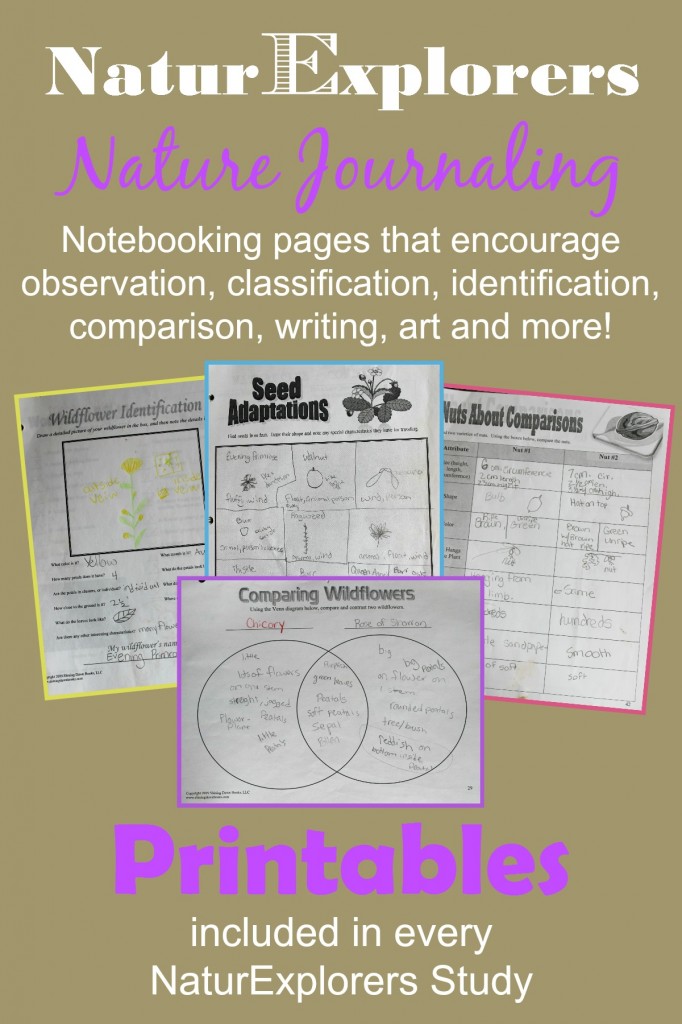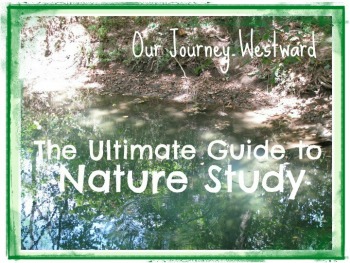Why Nature Journals Are Important
If you’ve been around here much, you know the importance I place on nature study. The real-life science lessons that offer a consistent “lab” experience are unmatched compared to simply studying the same topics from a textbook. But, just as important, nature study reaches so naturally into other academic areas that it’s priceless for gently integrated learning.

Today I’m focusing specifically on the nature journal and how it enhances learning through all subjects. There is no need to take a nature journal on every single nature walk, but make time for it frequently and see for yourself the wonderful learning that ensues.
This post contains affiliate links.
Nature journals reinforce observation skills.
Drawing the treasures found in nature naturally encourages children to notice the details – big and small. It’s during the sketching that my children will notice things they might otherwise pass right on by.

| 3 year old’s drawing of a flying butterfly |
Nature journals reinforce scientific language, descriptive language, and general vocabulary – not to mention, spelling.
Nature journal pages don’t always have to have writing on them, but it’s easy to naturally expect children to label sketches and/or write descriptions. Through these writings (or even simple discussions), vocabulary is readily taught.

| 4 year old’s sketch of an insect eaten leaf |
Nature journals allow for creativity.
Of course I’m talking about artistic creativity : what they draw and the art tools they choose to use. I think you’ll be surprised to notice, though, that children find very creative things in nature and very creative perspectives when allowed freedom in nature journaling. So many school lessons tell children exactly what to do, allowing them no freedom, that nature journaling can be a breath of fresh air – especially for the creative type.

| 5 year old’s drawing of sea life observed on vacation |
Nature journals naturally grow skills in art.
Consistent practice and frequent use of various art supplies makes for growing artists. I’ve been so pleased in the artistic growth of my children from simply using nature journals frequently: four times a month on average.
| 6 year old’s detailed drawing of roadside flowers |
Nature journals provide documentation of learning.
Some of you sweet mommas really like having papers in hand to prove that lessons have happened. While I don’t ever think a paper trail is necessary to prove learning, the nature journal certainly does leave a pretty paper trail showing proof of your amazing outdoor lessons.

| 7 year old’s drawing and description of autumn spider webs |
Nature journals promote real-life writing.
It’s pretty easy to see from our nature journal samples that writing becomes a bigger part of nature journaling as children get older. Beyond descriptions, we also tend to write poems, prayers and even small stories in our journals. Not only is the writing real-life (meaning it has a tangible purpose related to something they’ve been doing in real-life), I’ve found it to flow pretty easily compared to other writing assignments.

| 8 year old’s documentation of metamorphosis |
Nature journals encourage research-based learning.
When you stumble upon something you don’t know about on a nature walk, it’s very natural to want to learn what it is and what it does. So, out come field guides or other books or website search engines.
Because you’re documenting information, collecting data and maybe even noting experiment results, it’s easy to go back through nature journals to see patterns and make connections, too.

| 9 year old’s detailed description of ducks at a park |
Nature journals promote real-life mapping and graphing skills.
While you certainly can use maps to help you find your way around a nature area, nature journaling allows you to create your own maps as well. Drawing the insects you find in one-square foot of grass or creating a to-scale map of a pond and it’s plant life would be two examples.
And graphing information from nature walks is a very natural activity to do. Examples: Tally the number of various wildflowers you find. Collect leaves in the fall and create a pictograph. Make a bar graph to show how many various colored birds you saw.

| 10 year old’s documentation and reasoning of slug behavior |
Nature journals help us to love and care for creation – and love the Creator deeply.
When you’re in nature, interacting with nature and noticing every little detail about it, an interesting connection is born that makes you fall in love with the created world around you. More importantly, because of the beauty and amazing intricacies of each and every living thing, you are left with no doubt that we have an amazing Creator who is not only ultra-creative, but loves us enough to provide such wonderful things as you find in nature.
________________________________________
Note that nature journals can be in any format you like. We’ve used spiral drawing pads, blank white copy paper (that we file away in a three-ring nature or science binder), and prepared notebooking pages.
There is nothing specific that must be written in a nature journal. Drawings, labels, dates, weather conditions, descriptions of time/location/observations, poems, prayers, feelings, descriptive adjectives, stories, paintings, samples, data, graphs, photos…Any of these and more are completely wonderful to include.
________________________________________
Nature Study Resources
If you’re new to nature study and need to know where to start, I’ve put together the Ultimate Guide to Nature Study for you.
If that’s way too overwhelming, you might prefer the ready-to-go nature lessons {with notebooking suggestions} found in 100+ Creative Nature Walks or the printable nature notebook pages found in 40 Nature Walks: Science Labs On-the-Go.
-
 40 Nature Walks: Volume 2$24.00
40 Nature Walks: Volume 2$24.00 -
 40 Nature Walks: Volume 1$24.00
40 Nature Walks: Volume 1$24.00 -
 Creative Nature Walks$24.00
Creative Nature Walks$24.00
If you’re ready to go for it with nature walks, follow-up activities and a bazillion ideas for incorporating other academic areas, then you will find NaturExplorers studies to have everything you need. There are 19 different topics to choose from!
-
 Butterflies Flutter By$28.00
Butterflies Flutter By$28.00 -
 Peaceful Ponds$28.00
Peaceful Ponds$28.00 -
 Wonderful Wildflowers$28.00
Wonderful Wildflowers$28.00
If you really like the idea of nature journaling but can’t (or don’t want to) get outside, you might prefer the No Sweat Nature Study series. Your children can learn about nature and complete nature journal pages from the comfort of your home. There are several topics to choose from in this series, too!
-
 Math in Nature$20.00
Math in Nature$20.00 -
 Rainforest Biomes$20.00
Rainforest Biomes$20.00 -

And finally, if you simply want to turn the business of teaching nature study and nature journaling to someone else, I’m right here for you! I teach TWO live lessons per month in the No Sweat Nature Study LIVE membership. You can also find an entire library of previously recorded lessons to use with your children whenever you like! We always complete a nature journal page together while learning a bunch of nature-based science and scientific vocabulary.
Enjoy the wonderful learning and fabulous memories made through nature study and nature journaling!














Thanks for sharing. I love this idea. How do I start? Do I just take my 5 year old for a walk and bring the nature journal? Thanks again!
Tracey, you and your five year old will love nature study! Here’s a post that will get you started on the right foot…https://ourjourneywestward.com/nature-study-3/.
Thanks for your post. What resources do you use to teach the actual skills of art?
Amy, I’ve described some of my favorite resources for teaching art skills in the following posts. I hope they’re helpful to you!
https://ourjourneywestward.com/art-fundamentals/
https://ourjourneywestward.com/cave-paintings-ancient-history-art-project/
https://ourjourneywestward.com/artist-study-index-page/
Thanks!
Thanks for this article. We’re new to nature journaling and a bit overwhelmed. Your simple explanation and pictures make it seem so achievable! Really excited to show the kids and get started! 🙂 thanks again. I really appreciate the pictures starting at a toddler age as most examples I’ve seen look amazing but unachievable for us beginners. Lovely to see examples of the progress starting at the very start of nature journalling.
Yay! Thanks for sharing your comment, Monique. 🙂 I’d love to see some nature journal pictures once your sweet kiddos get started!
Thank you for this wonderful information on nature journals! This will help us out tremendously, as we are new to nature journals. Curious though, how would you create a pictograph by collecting leaves? My daughter loves collecting leaves, sticks, and rocks, so this sounds appealing since we have them already.
Thanks again!